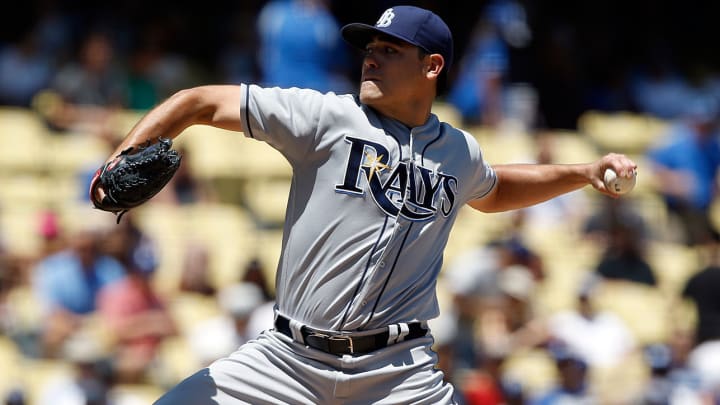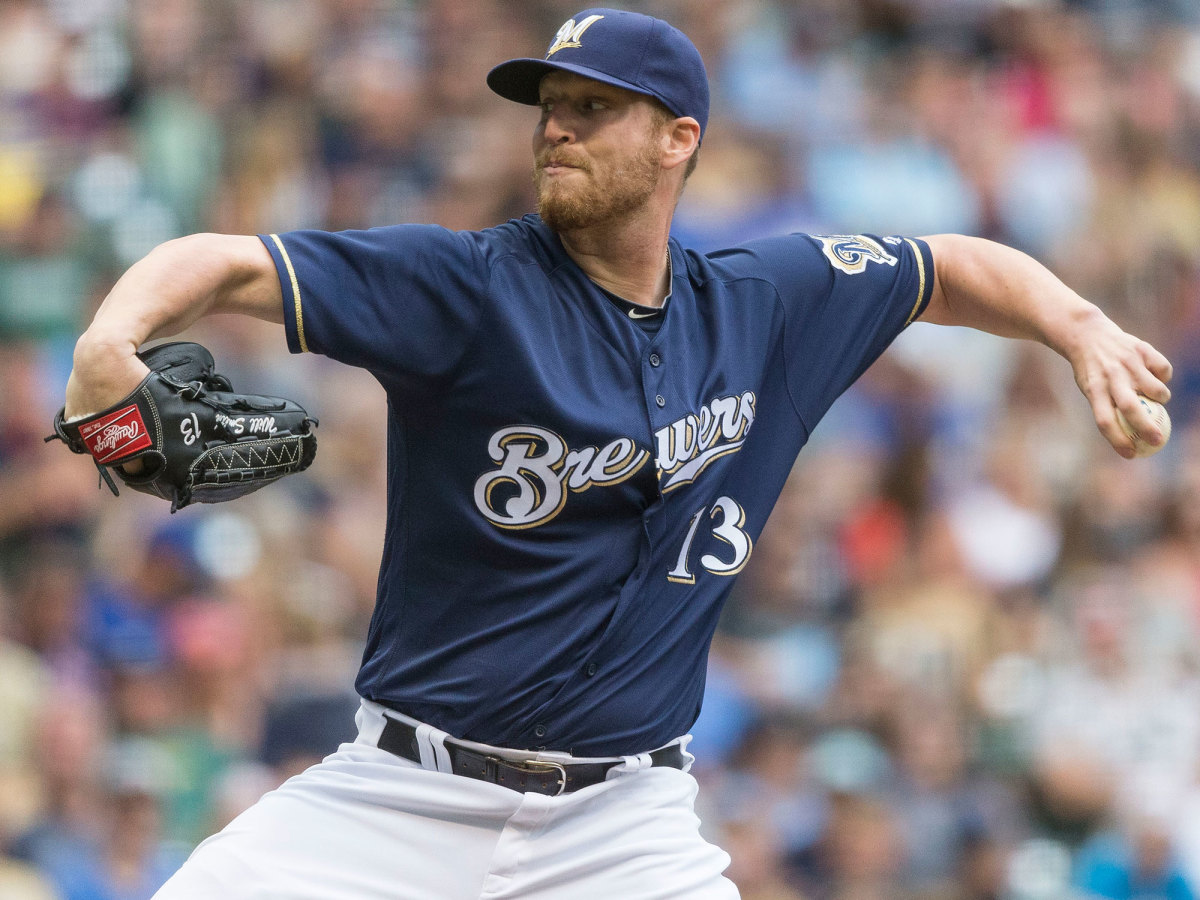Giants pick up Rays' Moore, Brewers' Smith in pair of trades

They paid a steep price in a sellers' market, but the Giants added a pair of lefthanded arms prior to Monday’s non-waiver trade deadline, acquiring starter Matt Moore from the Rays and reliever Will Smith from the Brewers. But unlike the deals made by their rivals for the National League West title—the Dodgers, who added impending free agents Josh Reddick and Rich Hill from the A’s and righty Jesse Chavez, also in his walk year, from the Blue Jays—the additions the Giants made will remain in San Francisco for years to come.
Moore and Smith, both of whom turned 27 midseason, are both controllable through the 2019 season—Smith via his remaining arbitration years, Moore via a team-friendly contract that includes a $7 million option for 2017, a $9 million option for '18 and a $10 million option for '19 (with buyouts descending in cost from $2.5 million to $1 million to $750,000). With 35-year-old Jake Peavy and 39-year-old Javier Lopez due to become free agents in November, the Giants now have their replacements on hand and locked up for three more seasons.
• Mets' trade for Jay Bruce is strange move for struggling team
In the short term, Moore will bounce either Peavy or Matt Cain from the Giants’ rotation. The lefty has had his struggles since his sensational debut at the age of 22 in 2011, including Tommy John surgery two years ago, but in his first full season since that procedure, he appears to be rounding back into form. Moore’s fastball velocity this season is higher than it has been since 2012; his walk rate, which was a major source of his struggles, is the lowest of his career (2.8 per nine); and his 2.73 strikeout-to-walk ratio is by far his highest since his brief 2011 debut. Boosting his value prior to Monday’s deadline, Moore posted a 2.39 ERA over his last nine starts, eight of them quality, topping off that run by holding the Dodgers to one unearned run in 6 2/3 innings in a 3–1 Rays win on Wednesday.
Despite that run and Moore’s obvious improvements this season, he is not and likely never will be the front-end starter he once projected to be. His success in those last nine starts has owed a lot to a .225 opponents batting average on balls in play, as he struck out just 6.9 men per nine innings over that stretch. Still, his home run rate, which was problematic early in the season, has been below league average over those nine starts, and his walk rate has gone down as well. Take him out of the AL East (home of the powerful Boston, Toronto and Baltimore offenses) and put him in the NL West, where pitchers hit, and he’s likely to be at least a solid mid-rotation arm going forward and well worth the $26 million over three years of his three options. Given that the Giants have Madison Bumgarner, Johnny Cueto and Jeff Samardizja in place for two of Moore’s remaining years of control and Cueto and Samardzija in place for all three, that’s all San Francisco needs him to be.
Moore’s contract may be a bargain that gives the Giants an out after every season following this one, but it didn’t come cheaply. To get Moore, San Francisco sent the Rays sophomore third baseman Matt Duffy (who was the runner-up for last year’s NL Rookie of the Year award), teenage shortstop prospect Lucius Fox (no, not Bruce Wayne’s business manager) and 21-year-old Class A righty Michael Santos.
• Dodgers bolster rotation, outfield with trade for Hill and Reddick
The Giants trading the 25-year-old Duffy was something of a shock. Coming into this season, he was expected to be their third baseman for the foreseeable future, but a poor start to the 2016 season followed by an Achilles injury in June—the first in a cascade of infield injuries—forced the Giants to replace him, at least temporarily. His initial replacement, Conor Gillaspie, is a former Giants first-round pick who posted a 115 OPS+ as the White Sox’s primary third baseman in 2014 and proved to be an upgrade at the plate. He will now likely cede the position to 2016 All-Star Eduardo Nuñez, who was acquired from the Twins on Thursday for pitching prospect Adalberto Mejia.
Nuñez, who can be erratic in the field, has hit .290/.326/.435 (105 OPS+) in 166 games over the last two seasons, stolen 36 bases at a 78% success rate and has been worth three wins above replacement over that span. At 29, he’s not a long-term solution, but he does have a year of team-control remaining, and fellow 29-year-old Gillaspie has two. The Giants’ hope is that by the time Nuñez reaches free agency, top prospect Christian Arroyo will be ready to take over at the hot corner. Arroyo was moved from shortstop to third base in Double A in mid-June, as he is blocked at his primary position through 2021 by Brandon Crawford.
With the Rays, the slick-fielding Duffy will be moved back to shortstop, which was his sole position in his first two professional seasons; incumbent shortstop Brad Miller, whose defense continues to undermine his above-average bat, will find playing time at first base and in the outfield—positions vacated in part by Monday’s trades of Steve Pearce to Baltimore and Brandon Guyer to Cleveland. Duffy began a rehab assignment with the Giants on Saturday and should return from his Achilles injury early this month.
Fox, a 19-year-old switch-hitting shortstop, was given a $6 million bonus when signed out of the Bahamas last July and was rated the Giants’ second-best prospect coming into the season by Baseball Prospectus. Athletic and fast with a strong arm and a quick bat, he has the tools to be a major league regular up the middle. He doesn’t project to have much power, however, and the Giants' aggressive placement—they put him in the full-season Sally League for his age-18 season—has resulted in an ugly batting line (.207/.305/.277). Santos, by comparison, took three seasons to work his way up to the Sally League at age 20. Now 21 and in his first full season at that level, the 6’4” righty has walked just five men in 58 2/3 innings over 10 starts and not allowed a single home run, but he has below-average strikeout rates and likely projects as a back-end starter.

For Smith, who is an above-average lefty set-up man having an off year after missing the first two months of the season due to a torn lateral collateral ligament in his right knee, the Giants gave up catcher Andrew Susac and their top pick in the 2015 draft, 6’4” righty Phil Bickford. Susac was obviously blocked by Buster Posey, but the 26-year-old former second-round pick is good enough on both sides of the ball to start behind the plate in the major leagues and likely will with Milwaukee (which did finally trade All-Star Jonathan Lucroy on Monday, sending him to the Rangers). A .260/.360/.434 career hitter in the minors, Susac hit .240/.309/.407 in 243 at-bats with the Giants spread over two seasons. Given a full-time job and a more team-friendly ballpark, he should exceed that line, which is itself better than what the average major league catcher has hit this season. He also grades out as an above-average pitch framer.
Bickford, the No. 18 pick in 2015 out of Cal State Fullerton, is a big, hard-throwing, 21-year-old righty with a three-quarters delivery who has had nothing but success in his first two professional seasons. He made the leap to high A ball in mid-June with little adjustment required and has now posted a 2.97 ERA, 1.01 WHIP, 10.7 strikeout-per-nine rate and 4.15 strikeout-to-walk rate in 115 1/3 professional innings. He’s far from a finished product, and some suspect his low release slot and the fact that his fastball spikes to the upper 90s in short stints could point to a future in the bullpen, but he’s a compelling arm in either role. More likely a mid-rotation arm than an ace, he is nonetheless a significant asset whom both BP and Baseball America rated as the Giants’ second-best pitching prospect (behind Tyler Beede) before the season and whom BA rated the organization’s third-best prospect overall.
That’s a fantastic return for Milwaukee, but you can understand it from the Giants' perspective if you consider Susac a player with no future in their organization—and his lack of a major league look this season suggests that was very much the case. With him as nothing more than a trade chip, the Giants essentially traded a future arm for a current one in the middle of a pennant race. Still, given the volatility of non-elite bullpen arms and Smith’s reverse split the last two years, it seems like a significant overpay. The Moore trade seems more likely to pay off for San Francisco in the short and long terms.
